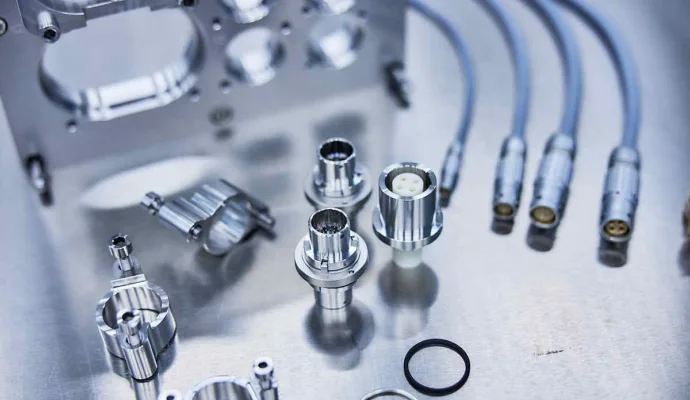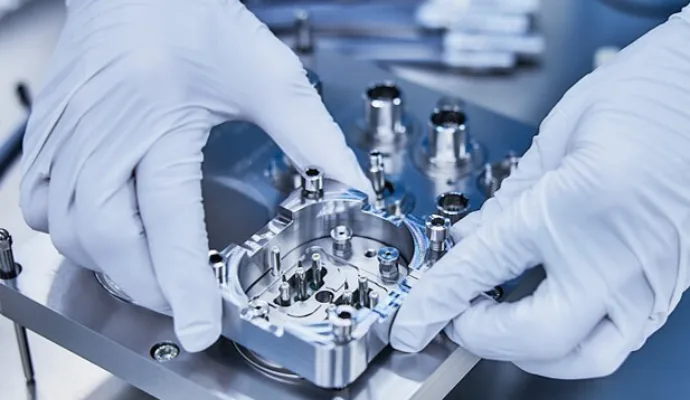How to Get Electrical Signals into a Hermetically Sealed Environment?

How to pass energy, signals and light from outside of a vacuum without leakage into a vacuum chamber? Hermetic sealing technology combines metal and glass to create vacuum-tight electrical connectors or feedthroughs that can be used in a wide range of applications.
An electrical conductor that carries signals and electrical power (voltages) through an enclosure or environmental barrier is called feedthrough. A simple and practical example of the application of a feedthrough connection we are all familiar with, is an automobile spark plug. The body of the plug must resist the pressure and temperature produced in the engine while providing a reliable electrical connection to the spark gap in the combustion chamber.
The environmental conditions a feedthrough should comply to, often play a critical role. In more complex fields of application such as oil and gas, the feedthrough must be engineered to be highly reliable and protected against extreme conditions. Whereas feedthroughs that are used in mechatronic systems often transfer signals from a not clean environment to a clean environment (vacuum), preventing particles from getting into a vacuum.
There are many different types of feedthrough options each serving a different purpose under various operating conditions. This article looks at the use of glass and ceramics as a sealing material in Electric feedthroughs. Some examples of electrical feedthroughs are hermetically sealed feedthroughs for instrumentation, high amperage and voltage, coaxial, thermocouple, and fiber optics feedthroughs.
In the next paragraphs we will look at some of the possible material choices, the specific advantage of glass and ceramics for electric feedthroughs and the processes of glass and metal sealing technology.
1. Insulating Capacities of Glass and Technical Ceramics
The selection of the right insulating material for a feedthrough depends on the degree of pressure, heat or mechanical resistance a signal should cope with. In case of electric feedthroughs the insulating capacities and heat resistance often play a key role. The loss of electricity or electrical leak can happen when electricity is transferred to a feedthrough flange and should be kept at a minimum. This can be prevented by using dielectric components such as glass or ceramics like Aluminum Oxide that are used to insulate the loaded pins from the metal flange. Hence technical ceramics such as Aluminum Oxide or Macor are often selected for its excellent insulating properties. Besides hermeticity, electric feedthroughs should also be able to cope with high or cryogenic materials.
2. Thermal Resistance of Glass
Plastics are often used in the flanges; however, most of these materials are not suitable for applications exposed to harsh environments such as high temperatures. A wide variety of plastics start to melt at 100 degrees Celsius, while high-performance plastics such as Polyetherimide (PE l) and Polyethersulfone (PES) are able to withstand up to 200 °C before starting to melt. For such applications, glass is a preferred sealing material as the bake-out step requires one to heat the sealing material and remove byproducts that in due time will cause outgassing.
Glass can only be molten at very high temperatures, whereas technical glass like borosilicate can withstand up to 600 °C and quartz up to 1100 °C. Depending on the intent of use, glass can be made of a variety of substances to match the desired heat resistance.
3. Low Outgassing of Glass and Technical Ceramics
Outgassing is usually the most relevant parameter to consider when designing vacuum applications. The vacuum causes non-metallic materials such as adhesives and polymers to release constituent material. The constituent material could include water vapor, oils, plasticizers, byproducts of the cure reaction, or other additives used in the seal material. This poses major challenges in highly sensitive applications, such as electron beam lithography systems and various other complex mechatronic systems , where cleanliness is paramount. When choosing the suitable materials for the seals, the material’s outgassing is a crucial consideration when working with a vacuum. Out of all materials, glass and technical ceramics have one of the lowest outgassing rates possible, much lower than plastics and even lower than most metals. This is because glass components are subjected to bake out at 2000°C, allowing the gasses to be almost completely eliminated.
Therefore, glass-to-metal and ceramic-to-metal sealing are often the main choices since this material combination provides the lowest possible outgassing, maintaining the clean environment within the vacuum.
4. Cleanability of Glass Materials
A clean and ultra-clean vacuum requires the highest standard of cleanliness. However, not all materials can be subjected to such standards due to their porousness or ability to withstand chemicals. Glass materials are not porous, meaning they have a smooth surface and can withstand high temperatures. Meanwhile, glass and technical ceramics like Aluminum Oxide or glass ceramics like Macor can withstand harsh chemicals used in some cleaning processes. These material properties of glass and technical ceramics, allow for various cleaning methods that achieve the highest cleaning standard suitable for vacuum applications, without deteriorating the material.
Electric feedthroughs require robust seals that maintain electrical integrity and long-life environmental sealing. As a result, glass-to-metal-seal technology is used instead of plastic seals. Glass-to-metal seals are hermetic and airtight seals that can withstand severe conditions such as high temperature, high pressure, vibration, moisture, and challenging chemical environments.
Glass-to-metal-seal feedthroughs have high-performance capabilities and are highly reliable. Glass-to-metal sealing is a technique to hermetically insulate electrical conductors that pass from one side of a barrier to the other. The glass melts to both package and pin, so it can act as an airtight barrier while at the same time providing insulation between the housing and the pins.

Glass-to-metal-seal feedthroughs can be broadly classified as signal and power feedthroughs. Power feedthroughs are used to transmit energy, often at a high current or high voltage, supporting 5 up to 150 Amps applications. These kinds of feedthroughs require glass-to-metal joints where the glass serves as electrical insulation between the conductor and connection flange. Ceramic materials can be added to provide double isolation on either side of the feedthrough barrier.
Signal or instrumentation feedthroughs, on the other hand, are used to carry electrical signals, including thermocouples. These signals can be low-current (milliamp) as well as low- or high-voltage signals from low- or high-impedance sources.
Another unique type of feedthrough also known as a RF feedthrough, is used for high-frequency Radio Frequency (RF) and microwave electrical signals. These are designed using a single pin with a metal shroud calculated on the basis of the glass dielectric constant to achieve a 50 or 75-ohm impedance at frequencies approaching 100 GHz. RF feedthrough high current needs can be met with the use of Copper-cored pins; meanwhile, glass-to-metal sealing technology provides reliable and rugged hermetic sealing that withstands harsh environments.
Glass-to-metal sealing is a proven and durable method that is often selected for its ability to withstand a high degree of pressure and extreme temperatures. The earliest applications of glass-to-metal sealing technology were vacuum tubes. However, now the technology is utilized in a wide range of applications, from glass diodes to hermetic electrical feedthroughs used in vacuum applications.
Creating a robust seal requires a strong chemical bond between two materials and a matching of the coefficient of thermal expansion (CTE) between the different materials. As a result, glass-to-metal sealed feedthroughs are made at high temperatures ranging from 500 -1100°C. The sealing process is always carefully managed to avoid any possible thermal mismatch and avoid any residual tension or stress in the joint. This is an important step in the process because the residual stress and tension in the joint could lead to rupture or separation between the metal and glass.
Ways to Seal/Fuse Glass to Metal
Matched Glass-To-Metal Sealing
Most of the applications operate in a wide range of temperatures; the components need to expand and contract at close to similar rates. This way, no misalignments or stresses will occur during the use of the product. One of the standard material combinations in the industry is a Borosilicate glass with a Kovar per ASTM F-15 (Fe-Ni-Co alloy). Borosilicate's thermal expansion coefficient is a very good match to Kovar over a different range of temperatures.
Compression Glass-to-Metal Sealing
A compression type of glass-to-metal sealing is preferred in cases where a feedthrough is designed for corrosion resistance, pressure capability, or conductor strength. Glass has a unique property of becoming stronger when compressed. The materials are specifically engineered for this sealing method to result in a positive pressure between the glass to metal joints. As a result, the performance of the seal thrives under pressure, as the overall system strength enhances in difficult mechanical environments.
In this article we have given some examples of electrical feedthroughs and the various material choices one needs to consider when trying to get the electrical signals in a vacuum. Furthermore, we have briefly explained how glass-to-metal sealing technology works and elaborated on some of the advantages of this sealing technology.
Besides the above mentioned applications there are many more possibilities that often require customized solutions. Our unique joining technology and the application of preferred materials and material combinations allow to realize the most complex designs.
Curious to find out how our electric feedthroughs could perform in your systems?
We are looking forward to talk to you about your design challenge.
